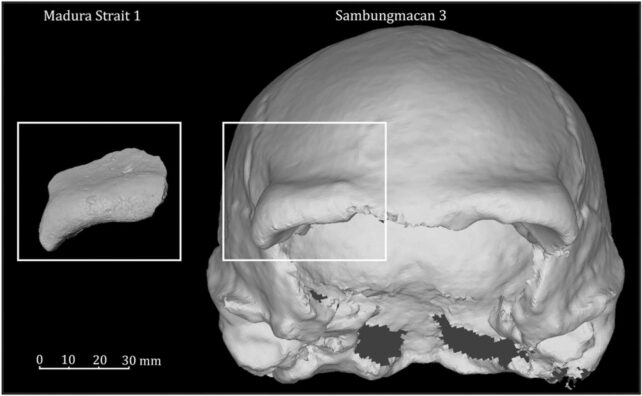On an artificial island of sand excavated from the seafloor of
Indonesia, evidence of a long-vanished sunken world inhabited by early humans has been accidentally discovered.
On the newly created island, scientists found more than 6,700 fish, reptile and mammal fossils recovered from the depths of the sea, including the remains of two hominid skulls. This is the first discovery of ancient human fossils between
islands of Indonesia. The bones belong to Homo erectus, the longest-lived of all ancient human relatives.
Until now, the only evidence for the existence of Homo erectus in this region was limited to the island of Java. But as it turns out, this population was not so isolated. More than 130,000 years ago, when sea levels were 100 meters lower than today, Homo erectus appears to have left Java and settled among the valleys and plains of the sunken Sundaland.
Sunda is the name of the largest submerged shelf in the world, which is located in Southeast Asia, although it is now a shallow sea, in the past it served as a land bridge between the Asian mainland and the islands of Borneo, Sumatra and Java.
This means that Homo erectus could even have come into contact with other species of humans living in Asia at the time, such as
Neanderthals or Denisovans.
"Homo erectus may have dispersed from the Asian mainland to Java," said the study's lead author and archaeologist Harry Berghuis of Leiden University in the Netherlands. "This makes our discovery truly unique. The fossils come from a flooded river valley that over time filled with river sand. We were able to date the material to around 140,000 years ago."
At the time, experts suggest, Sundaland resembled an African savannah. Among the fossils found on the artificial island were hippos, crocodiles,
elephants,
comod dragons,
rhinos, big cats and ungulates, ruminants similar to bison or buffalo. Most of these are now extinct.
Given the dry habitat of this prehistoric ecosystem, it is likely that Homo erectus adhered to the rivers in Sundaland, which may have provided a constant source of drinking water and fish. Experts suspect that hominids may also have hunted the big game that frequented these bodies of water.

.
Photo: sciencealert.com
"Our new findings include cut marks on aquatic turtle bones and a large number of broken cattle bones, indicating hunting and marrow consumption," Berghuis says. "We have not found such traces in the earlier Homo erectus population on Java, but we know them in more modern human species on the Asian mainland. Homo erectus may have copied this practice from these populations. This suggests that there may have been contact or even genetic exchange between these hominid groups. This is an interesting hypothesis, but more evidence is needed."
Past fossil discoveries on Java have led scientists to speculate that the island was the last stronghold of Homo erectus, a hominid that emerged
from Africa and crossed Asia in a highly impressive run of about 2 million kilometers. By 400,000 years ago, however, Homo erectus was extinct in Asia and Africa. In Java, however, the species persisted until about 108,000 years ago.
It is a great victory to retrieve the remains of Homo erectus from the seabed off the coast of Java, because the fossils were found between the small and narrow strait separating the two islands. How far Homo erectus traveled from Java remains a mystery. "The answers to these questions may well lie at the bottom of the sea," the authors write.